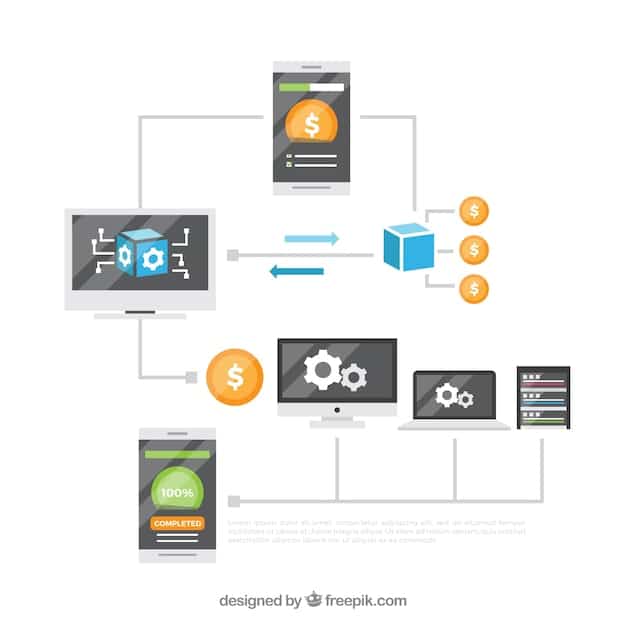Smart Contract Future: Trends and Predictions for 2025 and Beyond

The smart contract future envisions widespread adoption across various industries, with trends like advanced security measures, increased interoperability, and the integration of AI driving innovation and reshaping how agreements are executed and managed beyond 2025.
The future of agreements is being revolutionized by smart contract future: trends and predictions for 2025 and beyond. These self-executing contracts, coded onto blockchains, are streamlining processes, enhancing security, and fostering trust across diverse sectors, from finance to healthcare.
Understanding the Evolution of Smart Contracts
Smart contracts have evolved significantly since their inception. Initially conceived as simple digital agreements, they have now become complex tools capable of automating intricate business processes. Understanding this evolution is crucial for grasping their potential impact.
Early Stages of Smart Contracts
The initial smart contracts were basic, focusing on simple conditional transactions. They lacked the sophistication to handle complex logic or interact with external data sources.
Current Capabilities and Limitations
Today’s smart contracts can manage multi-party agreements, integrate with APIs, and even incorporate decentralized autonomous organizations (DAOs). However, they still face challenges related to scalability, security, and legal enforceability.
- Scalability Issues: Blockchain networks often struggle to process a high volume of smart contract transactions, leading to congestion and increased fees.
- Security Vulnerabilities: Smart contracts are susceptible to bugs and exploits, which can result in significant financial losses.
- Legal Ambiguity: The legal status of smart contracts remains unclear in many jurisdictions, creating uncertainty for businesses.
Smart contracts have come a long way, yet ongoing development is essential to overcome current hurdles and fulfil their complete capabilities.

Key Trends Shaping the Smart Contract Landscape
Several key trends are actively shaping the trajectory of smart contracts. These trends encompass technological advancements, industry adoption, and regulatory considerations, all of which will influence their future.
Enhanced Security Measures
As the value locked in smart contracts grows, so does the incentive for malicious actors. Enhanced security measures, such as formal verification and bug bounty programs, are becoming increasingly important.
Increasing Interoperability
Interoperability between different blockchain networks is essential for the widespread adoption of smart contracts. Projects like Polkadot and Cosmos are working to facilitate cross-chain communication.
Interoperability will improve how different blockchains “talk” to one another. This will allow tokens and data to move more seamlessly between different blockchains.
- Cross-Chain Communication: Enabling smart contracts on different chains to interact with each other.
- Standardized Protocols: Developing common standards for smart contract development and deployment.
- Atomic Swaps: Facilitating direct exchanges of tokens between different blockchains without intermediaries.
These measures are critical to broadening the effectiveness and usability of smart contracts across different platforms.
Predictions for Smart Contracts in 2025
Looking ahead to 2025, smart contracts are poised for significant advancements and broader adoption. Predictions range from increased automation to the integration of artificial intelligence.
Wider Industry Adoption
By 2025, smart contracts will likely be commonplace across various industries, including finance, supply chain management, healthcare, and real estate. This widespread adoption will drive efficiency and transparency.
Integration with IoT Devices
The integration of smart contracts with Internet of Things (IoT) devices will enable automated, secure interactions between physical objects and digital systems. For example, supply chain tracking could be automated using IoT sensors and smart contracts.

The incorporation of IoT devices will lead to more seamless, automated interactions.
The Role of AI in Smart Contract Development
Artificial intelligence (AI) is set to play a transformative role in the development and deployment of smart contracts. AI can enhance security, automate code generation, and improve decision-making within smart contract applications.
AI-Powered Security Audits
AI can be used to automatically identify vulnerabilities in smart contract code, reducing the risk of exploits. These AI-powered audits can analyze code more efficiently than manual reviews.
Automated Code Generation
AI can also assist in generating smart contract code, making it easier for developers to create and deploy complex agreements. This automation can significantly speed up the development process.
AI-driven solutions can automate tasks, and optimize performance in the realm of smart contracts.
Addressing the Challenges and Risks
Despite their potential, smart contracts face several challenges and risks that must be addressed to ensure their successful adoption. These include security vulnerabilities, scalability issues, and regulatory uncertainty.
Security Best Practices
Implementing robust security best practices is crucial to protect smart contracts from attacks. This includes using formal verification, conducting regular audits, and implementing bug bounty programs.
Scalability Solutions
Various scalability solutions are being developed to address the limitations of blockchain networks. These include layer-2 scaling solutions, sharding, and sidechains.
- Layer-2 Scaling: Processing transactions off-chain to reduce congestion on the main blockchain.
- Sharding: Dividing the blockchain into smaller, more manageable pieces.
- Sidechains: Creating separate blockchains that can interact with the main chain.
These solutions are critical for enabling smart contracts to handle a high volume of transactions efficiently.
Proper planning and execution in developing a smart contract framework will reduce exposure to risk.
Preparing for the Future of Smart Contracts
As smart contracts become more prevalent, individuals and organizations need to prepare for their integration into various aspects of life and business. This includes educating themselves, investing in the right technologies, and advocating for clear regulatory frameworks.
Education and Training
Investing in education and training is essential for developing the skills needed to create, deploy, and manage smart contracts. This includes training developers, legal professionals, and business leaders.
Strategic Investments
Organizations should strategically invest in technologies that support smart contract development and deployment. This includes blockchain platforms, development tools, and security solutions.
Smart contracts are gaining traction and becoming a crucial tool for organizations to promote efficiency.
| Key Aspect | Brief Description |
|---|---|
| 🔒 Enhanced Security | Advanced measures to protect against vulnerabilities and exploits. |
| 🌐 Interoperability | Seamless interaction between different blockchain networks. |
| 🤖 AI Integration | AI enhances security audits, code generation, and decision-making. |
| ⚙️ Industry Adoption | Widespread use across finance, supply chain, healthcare, and real estate. |
Frequently Asked Questions
▼
Smart contracts offer increased transparency, reduced costs, and enhanced security by automating agreement execution without intermediaries. They also improve efficiency and trust among parties.
▼
Smart contracts enhance security by using cryptographic techniques and blockchain immutability. This ensures that the terms cannot be altered, and every transaction is securely logged and verified.
▼
AI will automate security audits, generate code, and improve governance. It helps identify vulnerabilities and optimize contract performance, and facilitates complex automated decision-making processes within smart contracts.
▼
Finance, supply chain management, healthcare, and real estate are the primary industries. These sectors will leverage smart contracts to streamline processes, reduce fraud, and automate transactions.
▼
Security vulnerabilities, scalability issues, and regulatory uncertainty pose major challenges. Overcoming these hurdles involves better coding practices, advanced scaling solutions, and supportive legal frameworks.
Conclusion
The smart contract future holds immense potential for transforming how agreements are managed and executed. By addressing current challenges and embracing emerging trends such as AI integration and enhanced security measures, smart contracts are poised to revolutionize industries and redefine trust in the digital age.





